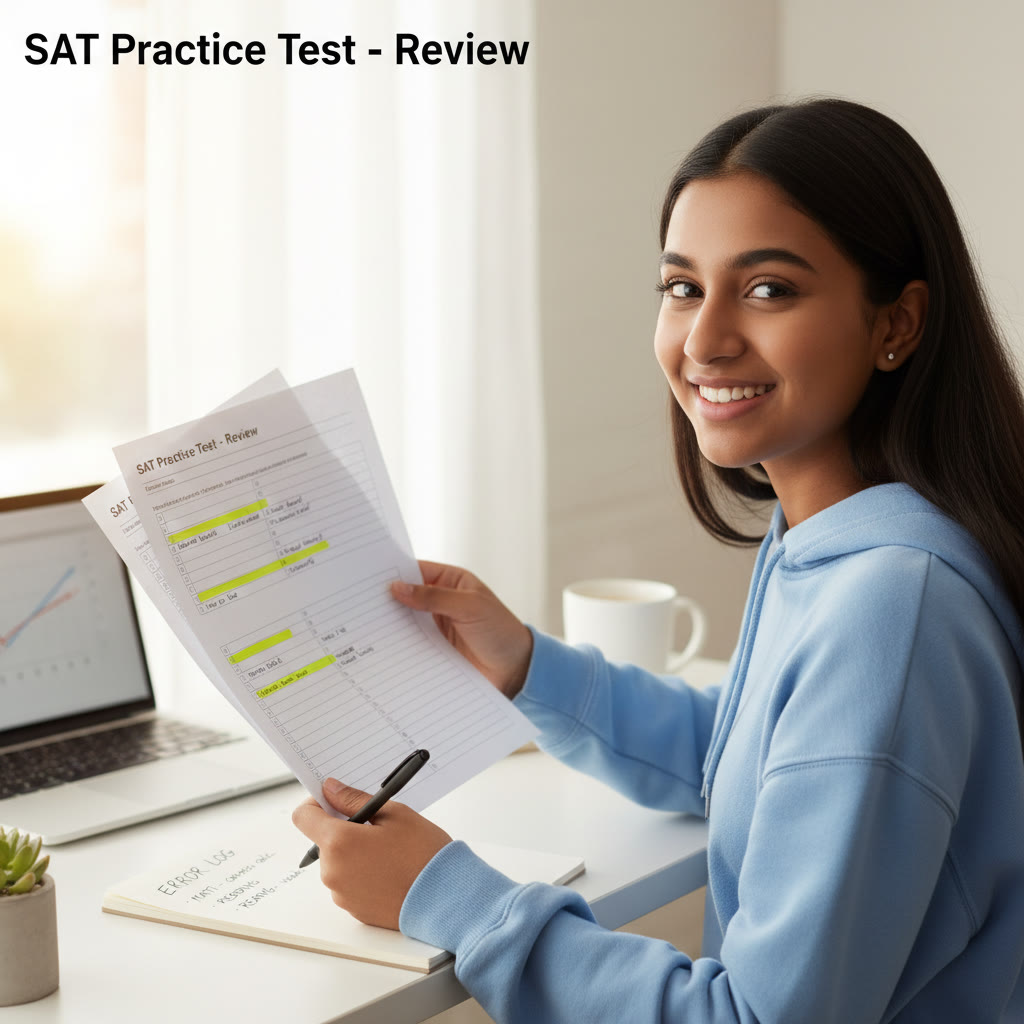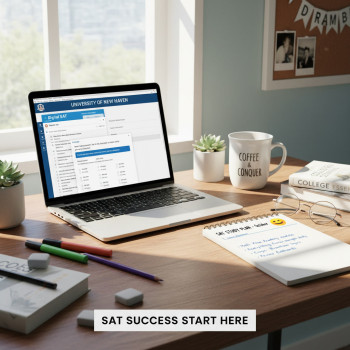Why this guide exists (and why it will help you)
Preparing for the SAT can feel like trying to learn a new language while juggling homework, extracurriculars, and a social life. It gets trickier when you don’t have unlimited access to a tutor. Maybe your school offers only a handful of sessions, or your family can afford a few 1-on-1 meetings instead of weekly lessons. The good news is this: limited tutoring does not mean limited progress. With smart planning, targeted practice, and efficient use of any personal tutoring time you do get — including Sparkl’s personalized tutoring and AI-driven insights when available — you can make large, measurable gains.

Start with an honest diagnostic
Simulate a real test
Before you write a single flashcard, take a full-length, timed practice SAT to learn where you are. Use the same time limits, no interruptions, and the same breaks the actual test gives. Treat it like a rehearsal for the big day.
What to track from the diagnostic
- Raw scores by section (Reading, Writing & Language, Math No Calculator, Math Calculator)
- Types of questions missed (e.g., inference, function problems, punctuation)
- Time management issues (which passages or sections took too long?)
- Mental state (was fatigue an issue? Did you panic on a passage?)
This baseline gives you two priceless things: perspective (you’ll stop guessing how strong you are) and direction (you’ll know what to prioritize when tutoring time is limited).
Design a focused study plan
Principles for limited-tutoring schedules
- Prioritize weaknesses: fix high-impact errors first (e.g., major algebra gaps beat polishing minor grammar nuances).
- Make each minute count: plan specific goals for every study block or tutor session.
- Use spaced repetition: revisit topics at increasing intervals to retain gains.
- Mix practice types: combine untimed conceptual review, timed sections, and error analysis.
Sample study schedules
Below are three compressed study schedules that assume limited tutoring contact (e.g., one 1-hour session every two weeks). Use the plan that best matches your test date and available time.
| Timeline | Weekly Hours | Focus | When to use tutoring sessions |
|---|---|---|---|
| 6 weeks | 12–15 hrs | Rapid triage: timed practice, error logs, core math concepts, reading strategies | Every other week: practice review, target the biggest recurring error |
| 3 months | 6–8 hrs | Build foundations, steady timed practice, vocabulary in context, algebra review | Biweekly: check progress, refine strategy, practice test review |
| 6 months | 4–6 hrs | Deep mastery: content gaps, strategy refinement, multiple full-lengths | Monthly or flexible: targeted deep dives, long-term habit coaching |
The table above shows a practical allocation. Notice the consistent theme: more frequent and focused practice compensates for limited live tutoring. When you do get that Sparkl 1-on-1 time, bring a concise plan, your error log, and concrete questions — tutors can then laser-target your trouble spots using tailored study plans and AI-driven insights.
Make your limited tutoring sessions extremely effective
Before the session: prepare like a pro
- Send a one-paragraph summary of your recent practice and biggest struggles so the tutor starts the session already prepared.
- Pinpoint two specific objectives for the meeting (e.g., “Help me fix algebraic manipulation mistakes” or “Show methods to improve reading speed without losing accuracy”).
- Bring exact examples from practice tests — the most useful moments are when the tutor can work through your actual mistakes, not abstract questions.
During the session: be deliberate
- Ask the tutor to model a thought process for 2–3 questions rather than giving quick answers.
- Request short, actionable strategies you can apply immediately in practice (mnemonics, checklists, or step-by-step templates).
- Use the last 5–10 minutes for a micro-plan: what to do next two weeks, what problems to prioritize, and how you’ll report back.
After the session: convert guidance into habit
- Write a one-page summary of what you learned and the concrete practice tasks you promised to complete.
- Schedule short daily practice blocks that align with the tutor’s recommendations.
- If you have access to Sparkl’s AI-driven insights, upload practice results for tailored homework between sessions.
High-impact study techniques when tutoring is scarce
Error logs: the secret weapon
Keep an error log in a notebook or a simple spreadsheet. For every missed question record: the question type, why you missed it, the correct reasoning, and a short action step to prevent the error happening again. After 20–30 entries patterns emerge — and that’s where limited tutoring delivers the greatest return: a tutor can eliminate recurring patterns, not isolated one-off mistakes.
Smart timed practice
Timed practice trains both accuracy and pacing. Instead of constantly doing full-length tests, use a mix: short targeted timed sets (10–15 questions), one full section under real timing once or twice a week, and a full-length test once every 2–3 weeks. This rhythm preserves energy and makes each testing experience more informative.
Active review beats passive review
- When you check answers, explain the correct solution out loud in your own words.
- Create mini-teach sessions: pretend you’re teaching the solution to a friend or record a short video of your explanation.
- Turn insights into flashcards for formulas, grammar rules, and common traps.
Section-by-section strategies
Reading
Think of the Reading section as a series of micro-dramas: each passage has actors (authors), motives (arguments), and scenes (paragraphs). Training your eye to catch the author’s main point, the structure, and where evidence lives is more valuable than trying to memorize vocabulary lists.
- Skim the questions first only when you’re struggling with time; otherwise, read actively for main idea and tone.
- Underline key phrases and transitions (“however,” “for example,” “in contrast”) — they often mark the logic of the passage.
- For inference questions, find the passage evidence that most directly supports the answer; weakly supported choices are usually tempting but wrong.
Writing & Language
This section rewards pattern recognition. Focus on the most-tested grammar and style rules: subject-verb agreement, verb tense consistency, punctuation for clauses, parallel construction, and concise expression.
- Create a short, portable cheat-sheet of the 8–10 rules you encounter most often.
- Practice by correcting paragraphs under time pressure and then checking explanations carefully.
Math (No Calculator and Calculator)
Math is both skill and pattern. When you have limited tutoring, strengthen the foundations that cut across many problems: linear equations, systems, functions, ratios, and common geometry formulas.
- Memorize a few staple formulas (area, perimeter, Pythagorean theorem, circle relationships) so you don’t waste time deriving them during the test.
- Practice translating word problems into equations — that’s often the real barrier.
- Use mental math tricks to simplify expressions quickly on the No Calculator section, and reserve the calculator for complex arithmetic in the Calculator portion.
Use technology and self-study tools strategically
What to prioritize
- Official practice material — it mirrors the real test’s question styles and difficulty.
- Short video explanations for tricky concepts — pick those that model problem-solving visibly.
- Practice question banks where you can filter by question type: repetition on the same type builds automaticity.
If you’re working with Sparkl’s personalized tutoring, combine these resources with the tutor’s recommendations. Sparkl’s AI-driven insights can analyze practice results to suggest the highest-yield topics to study between sessions — an advantage when face-to-face time is limited.
Case studies: two students making big gains with sparse tutoring
Asha: 6-week sprint to raise a score by 120 points
Asha had a month and a half before her test and two 1-hour tutoring sessions. She used this approach: a diagnostic, then a tightly focused error log, six timed math sets per week (15 questions each), and one full-length test every 10 days. Her tutor used each live session to correct recurring algebra mistakes and show efficient ways to set up equations. Asha’s disciplined, focused practice — guided by brief, strategic tutor checkpoints — produced a 120-point improvement.
Ben: steady progress over 4 months with monthly tutoring
Ben spread his work across four months with one monthly 1-on-1 from Sparkl. He logged every error, recorded himself explaining solutions, and prioritized comprehension over speed at first. The tutor’s monthly visits were used for deeper conceptual clarifications and to adjust Ben’s study plan. By the test date Ben had built durable habits and improved timing, gaining roughly 140 points.
Practical tools you can build today
An error-log template (simple)
- Date | Section | Question # | Mistake type | Why I missed it | Correct idea | Action step
Daily 45-minute practice block (example)
- 5 minutes: quick warm-up (mental math or grammar rule review)
- 25 minutes: focused practice (10–15 problems or one passage)
- 10 minutes: error log and review
- 5 minutes: plan tomorrow’s mini-goal
Test-day and mindset strategies
Fatigue is a stealth score-thief
A big part of doing well on the SAT is being human. Get consistent sleep the week before, eat a balanced breakfast on test day, and finish your last practice a day before the test — not the night before. If you’ve used short, frequent practice sessions during prep, your stamina will be solid.
When you get stuck
- Flag the question and move on; don’t let one problem cost you time for multiple questions.
- Use process of elimination to increase odds when you must guess — eliminate any clearly wrong answers first.
- Breathe and reset between passages. Two deep breaths can break a cycle of panic and improve clarity of thought.
How to continue improving after limited tutoring
Learning is cumulative. After each practice test, return to your error log and revise your plan. If you have periodic sessions with Sparkl’s tutors, use them explicitly for pattern elimination — they can give concise frameworks and homework that multiply the return on each hour you spend together. If you don’t have additional tutoring, consider peer review, study groups, or recorded explanations you create yourself to double down on comprehension.
Final encouragement and next steps
Limited tutoring access is not a ceiling — it’s a constraint you can work around. With deliberate diagnostics, focused practice, a sharp error log, and a plan for how to use each scarce tutoring minute, you can make steady, meaningful progress. When you do get time with a tutor, whether a single session or periodic check-ins, prioritize patterns over one-off questions and convert guidance into short, repeatable tasks.
Remember: consistency beats intensity when time is short. A little focused practice every day compounds faster than an all-night cram. And when you choose to bring in personalized help, make it count by being prepared, asking for modeling, and asking for a clear two-week action plan. With these habits — and by leveraging tools like Sparkl’s personalized tutoring and AI-driven insights where they fit naturally into your prep — you’ll be surprised how far you can go.

Now, take one step: do a timed diagnostic today, write one item in your error log, and set a 45-minute block for tomorrow. Small steps stack into big results. You’ve got this.

















No Comments
Leave a comment Cancel